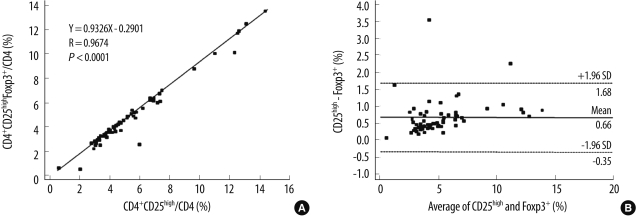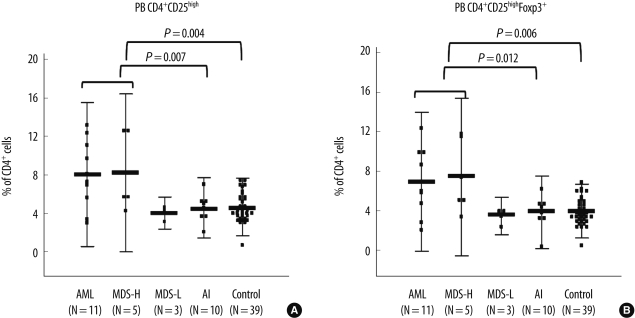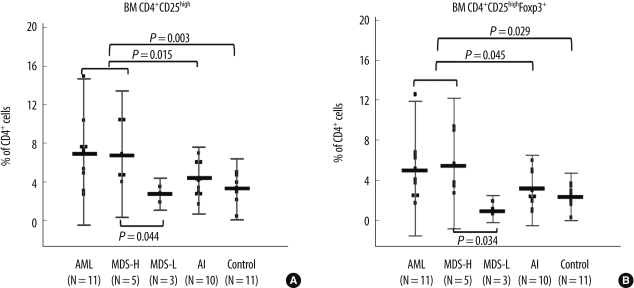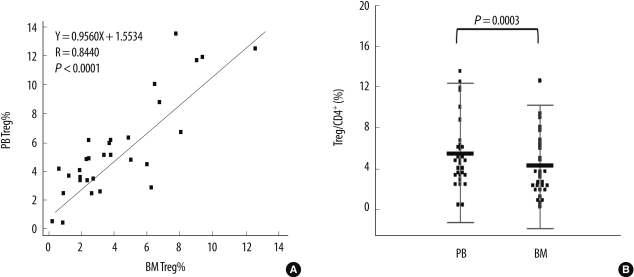Korean J Lab Med.
2011 Oct;31(4):231-237. 10.3343/kjlm.2011.31.4.231.
CD4+CD25highFoxP3+ Regulatory T-cells in Hematologic Diseases
- Affiliations
-
- 1Department of Laboratory Medicine, Konkuk University School of Medicine, Seoul, Korea. dearmina@hanmail.net
- 2Department of Internal Medicine, Konkuk University School of Medicine, Seoul, Korea.
- KMID: 1781685
- DOI: http://doi.org/10.3343/kjlm.2011.31.4.231
Abstract
- BACKGROUND
CD4+CD25+ regulatory T-cells (Tregs) play a critical role in immune responses. We explored the status of Tregs in neoplastic and autoimmune hematologic diseases. We also evaluated the technical aspects of Treg measurement in terms of sample type and detection markers.
METHODS
A total of 68 subjects were enrolled: 11 with AML, 8 with MDS, 10 with autoimmune diseases, and 39 controls. Tregs were analyzed in peripheral blood (PB) and bone marrow (BM) samples from each subject. Flow cytometry and the Human Regulatory T cell Staining Kit (eBioscience, USA) for CD4, CD25, and FoxP3 (forkhead box P3) were used.
RESULTS
The CD4+CD25high/CD4 and CD4+CD25highFoxP3+/CD4 populations were significantly correlated (P<0.0001). The AML and high-risk MDS groups had significantly larger CD4+CD25high/CD4 and CD4+CD25highFoxP3+/CD4 populations in PB than the autoimmune (P=0.007 and 0.012, respectively) and control groups (P=0.004 and 0.006, respectively). Comparable findings were observed in BM. The CD4+CD25highFoxP3+/CD4 population was significantly larger in PB than in BM (P=0.0003).
CONCLUSIONS
This study provides comparison data for Tregs in AML, MDS, and autoimmune hematologic diseases, and would be helpful for understanding the different immunologic bases of various hematologic diseases. Treg measurement using CD4, CD25, and/or FoxP3 in PB rather than in BM seems to be practical for routine hematologic purposes. Large-scale analysis of the diagnostic role of Treg measurement is needed.
MeSH Terms
-
Adolescent
Adult
Aged
Aged, 80 and over
Autoimmune Diseases/diagnosis/immunology
Bone Marrow Cells/cytology
Female
Flow Cytometry
Forkhead Transcription Factors/*metabolism
Hematologic Diseases/*diagnosis/immunology
Humans
Interleukin-2 Receptor alpha Subunit/*metabolism
Leukemia, Myeloid, Acute/diagnosis/immunology
Leukocytes, Mononuclear/cytology
Male
Middle Aged
Myelodysplastic Syndromes/diagnosis/immunology
T-Lymphocytes, Regulatory/immunology/*metabolism
Figure
Reference
-
1. Sakaguchi S, Yamaguchi T, Nomura T, Ono M. Regulatory T cells and immune tolerance. Cell. 2008; 133:775–787. PMID: 18510923.
Article2. Hori S, Nomura T, Sakaguchi S. Control of regulatory T cell development by the transcription factor Foxp3. Science. 2003; 299:1057–1061. PMID: 12522256.3. Ozdemir C, Akdis M, Akdis CA. T regulatory cells and their counterparts: masters of immune regulation. Clin Exp Allergy. 2009; 39:626–639. PMID: 19422105.
Article4. Sakaguchi S. Regulatory T cells: key controllers of immunologic self-tolerance. Cell. 2000; 101:455–458. PMID: 10850488.5. Kim JM, Rasmussen JP, Rudensky AY. Regulatory T cells prevent catastrophic autoimmunity throughout the lifespan of mice. Nat Immunol. 2007; 8:191–197. PMID: 17136045.
Article6. Wang HY, Wang RF. Regulatory T cells and cancer. Curr Opin Immunol. 2007; 19:217–223. PMID: 17306521.
Article7. Curiel TJ, Coukos G, Zou L, Alvarez X, Cheng P, Mottram P, et al. Specific recruitment of regulatory T cells in ovarian carcinoma fosters immune privilege and predicts reduced survival. Nat Med. 2004; 10:942–949. PMID: 15322536.
Article8. Woo EY, Chu CS, Goletz TJ, Schlienger K, Yeh H, Coukos G, et al. Regulatory CD4(+)CD25(+) T cells in tumors from patients with early-stage non-small cell lung cancer and late-stage ovarian cancer. Cancer Res. 2001; 61:4766–4772. PMID: 11406550.9. Yang ZZ, Novak AJ, Stenson MJ, Witzig TE, Ansell SM. Intratumoral CD4+CD25+ regulatory T-cell-mediated suppression of infiltrating CD4+ T cells in B-cell non-Hodgkin lymphoma. Blood. 2006; 107:3639–3646. PMID: 16403912.
Article10. Ichihara F, Kono K, Takahashi A, Kawaida H, Sugai H, Fujii H. Increased populations of regulatory T cells in peripheral blood and tumor-infiltrating lymphocytes in patients with gastric and esophageal cancers. Clin Cancer Res. 2003; 9:4404–4408. PMID: 14555512.11. Sato E, Olson SH, Ahn J, Bundy B, Nishikawa H, Qian F, et al. Intraepithelial CD8+ tumor-infiltrating lymphocytes and a high CD8+/regulatory T cell ratio are associated with favorable prognosis in ovarian cancer. Proc Natl Acad Sci U S A. 2005; 102:18538–18543. PMID: 16344461.
Article12. Kordasti SY, Ingram W, Hayden J, Darling D, Barber L, Afzali B, et al. CD4+CD25high Foxp3+ regulatory T cells in myelodysplastic syndrome (MDS). Blood. 2007; 110:847–850. PMID: 17412885.
Article13. Motta M, Rassenti L, Shelvin BJ, Lerner S, Kipps TJ, Keating MJ, et al. Increased expression of CD152 (CTLA-4) by normal T lymphocytes in untreated patients with B-cell chronic lymphocytic leukemia. Leukemia. 2005; 19:1788–1793. PMID: 16094420.
Article14. Beyer M, Kochanek M, Giese T, Endl E, Weihrauch MR, Knolle PA, et al. In vivo peripheral expansion of naive CD4+CD25high FoxP3+ regulatory T cells in patients with multiple myeloma. Blood. 2006; 107:3940–3949. PMID: 16410445.15. Nadal E, Garin M, Kaeda J, Apperley J, Lechler R, Dazzi F. Increased frequencies of CD4(+)CD25(high) T(regs) correlate with disease relapse after allogeneic stem cell transplantation for chronic myeloid leukemia. Leukemia. 2007; 21:472–479. PMID: 17215853.
Article16. Wang X, Zheng J, Liu J, Yao J, He Y, Li X, et al. Increased population of CD4(+)CD25(high), regulatory T cells with their higher apoptotic and proliferating status in peripheral blood of acute myeloid leukemia patients. Eur J Haematol. 2005; 75:468–476. PMID: 16313258.
Article17. Swerdlow S, Campo E, editors. WHO classification of tumours of hematopoietic and lymphoid tissue. 2008. Lyon: IARC Press.18. Kotsianidis I, Bouchliou I, Nakou E, Spanoudakis E, Margaritis D, Christophoridou AV, et al. Kinetics, function and bone marrow trafficking of CD4+CD25+FOXP3+ regulatory T cells in myelodysplastic syndromes (MDS). Leukemia. 2009; 23:510–518. PMID: 19020538.
Article19. Sloand EM, Rezvani K. The role of the immune system in myelodysplasia: implications for therapy. Semin Hematol. 2008; 45:39–48. PMID: 18179968.
Article20. Aggarwal S, van de Loosdrecht AA, Alhan C, Ossenkoppele GJ, Westers TM, Bontkes HJ. Role of immune responses in the pathogenesis of low-risk MDS and high-risk MDS: implications for immunotherapy. Br J Haematol. 2011; 153:568–581. PMID: 21488861.
Article21. Azuma T, Takahashi T, Kunisato A, Kitamura T, Hirai H. Human CD4+ CD25+ regulatory T cells suppress NKT cell functions. Cancer Res. 2003; 63:4516–4520. PMID: 12907625.22. Beyer M, Schultze JL. Regulatory T cells in cancer. Blood. 2006; 108:804–811. PMID: 16861339.
Article23. Feyler S, von Lilienfeld-Toal M, Jarmin S, Marles L, Rawstron A, Ashcroft AJ, et al. CD4(+)CD25(+)FoxP3(+) regulatory T cells are increased whilst CD3(+)CD4(-)CD8(-)alphabetaTCR(+) Double Negative T cells are decreased in the peripheral blood of patients with multiple myeloma which correlates with disease burden. Br J Haematol. 2009; 144:686–695. PMID: 19133978.24. Solomou EE, Rezvani K, Mielke S, Malide D, Keyvanfar K, Visconte V, et al. Deficient CD4+ CD25+ FOXP3+ T regulatory cells in acquired aplastic anemia. Blood. 2007; 110:1603–1606. PMID: 17463169.
Article25. Szczepanski MJ, Szajnik M, Czystowska M, Mandapathil M, Strauss L, Welsh A, et al. Increased frequency and suppression by regulatory T cells in patients with acute myelogenous leukemia. Clin Cancer Res. 2009; 15:3325–3332. PMID: 19417016.
Article
- Full Text Links
- Actions
-
Cited
- CITED
-
- Close
- Share
- Similar articles
-
- Alteration of CD4+CD25+Foxp3+ T cell level in Kawasaki disease
- Peripheral Generation of CD4+ CD25+ Foxp3+ Regulatory T Cells
- IL-4 Induces CD4+CD25+ Regulatory T Cells from CD4+CD25- T Cells in Peripheral Blood
- Dynamic Frequency of Blood CD4+CD25+ Regulatory T Cells in Rats with Collagen-induced Arthritis
- Regulatory T Cells and Allogeneic Transplantation






